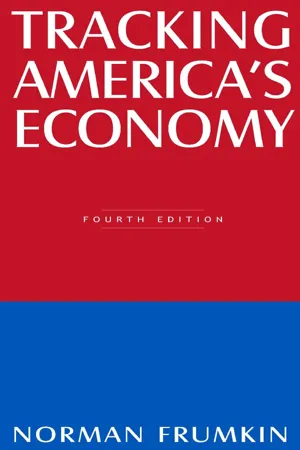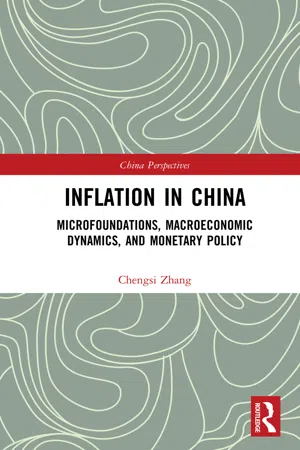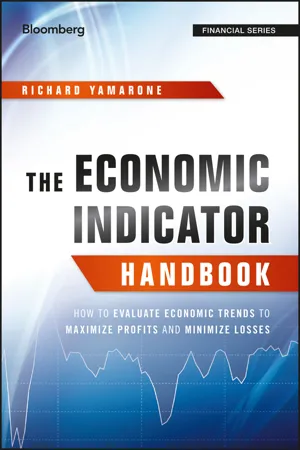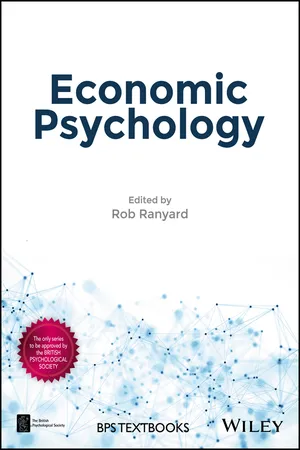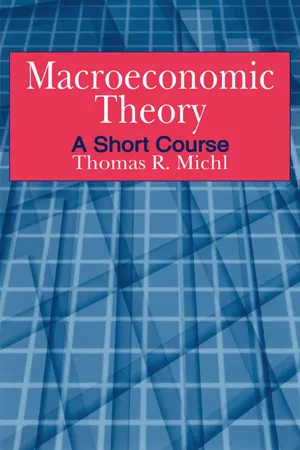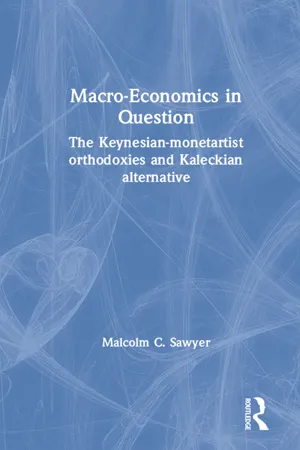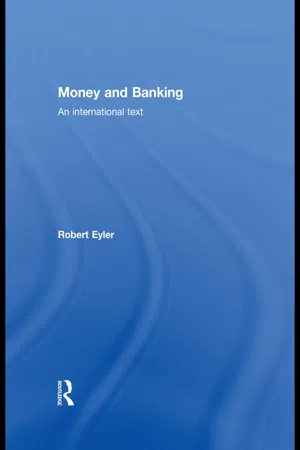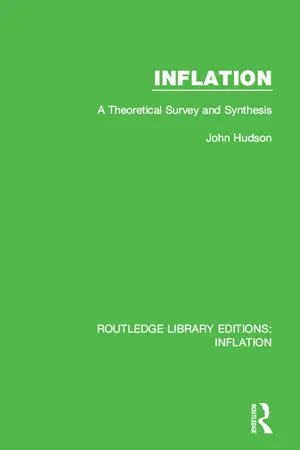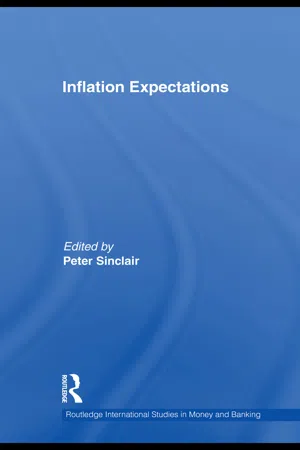Economics
Expected Inflation
Expected inflation refers to the anticipated rate at which the general level of prices for goods and services is expected to rise over a specific period. It is a key factor in economic decision-making, influencing investment, borrowing, and spending. Expected inflation is often used in economic models and policy discussions to assess its impact on various aspects of the economy.
Written by Perlego with AI-assistance
Related key terms
Related key terms
1 of 4
Related key terms
1 of 3
10 Key excerpts on "Expected Inflation"
- eBook - ePub
- Norman Frumkin(Author)
- 2015(Publication Date)
- Routledge(Publisher)
Tolerable inflation is another qualitative term, which typically represents an annual inflation rate of around 3 to 5 percent. It incorporates a value judgment that implies inflation should be lower, because the rate erodes the incomes of large segments of the population whose wages, profits from self-employment, interest and dividends from savings and investments, or retirement annuities do not keep pace with inflation. At the same time, the rate is not thought to cause extreme speculative behavior among households and businesses, nor does it lead to spiraling increases in interest rates.Price and Wage Expectations
As measured by the average annual change in the CPI, prices of goods and services items typically bought by households have risen in all years from the 1940s to the early 2000s, except for 1949 and 1955. By contrast, consumer prices declined in four years of the 1920s and six years of the 1930s. Thus, inflation, though at varying rates, seems to be built into the economy since the end of the depression of the 1930s. One reason is that some prices and wages are set by mUltiyear contracts that call for scheduled increases over the life of the contract regardless of changing economic conditions. Another is that while some prices and wages actually decline during recessions or during periods of slow economic growth, the more typical experience during such periods is that the rate of increase only slows. Expectations of price change are an important intangible to monitor because they affect the behavior of businesses, workers, lenders, and borrowers in the determination of prices, wages, and interest rates. Expectations, at least temporarily, tend to be self-fulfilling forecasts. For example, when there is an expectation of high inflation, the various groups try to insulate themselves by raising price, wage, and interest rate demands in order to maintain the purchasing power of their future incomes. Similarly, an expectation of low inflation leads to smaller price, wage, and interest rate demands. Inflationary expectations helped fuel the large price increases in the 1970s, while lower inflationary expectations in the 1980s, 1990s, and early 2000s helped moderate price increases in those periods. - eBook - ePub
Inflation in China
Microfoundations, Macroeconomic Dynamics, and Monetary Policy
- Chengsi Zhang(Author)
- 2020(Publication Date)
- Routledge(Publisher)
10 Inflation expectations and its dynamic mechanism10.1 Types of inflation expectations
Inflation expectations are an important variable in the modern macroeconomic analysis framework. In particular, the micro-based New Keynesian Phillips curve model developed in recent years highlights the impact of inflation expectations on real inflation (such as Gali and Gertler, 1999). However, in the macroeconomic analysis framework, inflation expectations are generally obtained using the rational expectations or the adaptive expectations hypothesis. Therefore, inflation expectations are only statistically variable indicators in such an analysis framework, but not public expectations of inflation in reality.The problem of inflation expectations management has always been the focus of general concern, and relevant theoretical research and applied research have yielded rich results. Although existing studies differ in terms of analytical perspectives, analytical methods, and analytical priorities, it is generally believed that the sound management of inflation expectations is a central task for central bank to suppress inflation. Existing studies have shown that rising inflation expectations can increase aggregate demand while cutting aggregate supply, leading to a rise in overall price levels. In fact, panic buying in the 1980s in China and the excessive boom in the domestic stock market and real estate market before the 2007–2008 global financial crisis are all related to inflation expectations to a certain extent. Because inflation expectations can affect the public’s consumption and investment modes and affect the overall economic performance, stable inflation expectations help monetary policy to play a better role, and the stability of inflation expectations is of central significance for the inflation trend and overall economic performance (Mishkin, 2007a). - eBook - ePub
The Economic Indicator Handbook
How to Evaluate Economic Trends to Maximize Profits and Minimize Losses
- Richard Yamarone(Author)
- 2016(Publication Date)
- Bloomberg Press(Publisher)
Chapter 10 Prices and InflationInflation exists when the price of an item or service increases. Over the course of the business cycle, it is common for price measures to exhibit particular patterns, which will tell an investor a great deal about the underlying tone and current of the economy. For the most part, a certain level of inflation in the economy is normal, even desired. Accelerating inflation, however, can cause severe problems, sometimes triggering a recession. A declining price level is also a caustic condition and may result in undesirable economic consequences.The inflation rate can tell us a great deal about economic activity. When the economy is strengthening and people are employed with solid incomes, companies experience increased demand for their products and so can charge higher prices for them. As a result, revenues increase, lifting profits and permitting companies to boost capital investment and create new jobs. At a particular level, however, higher prices squeeze consumers, who may have to choose where to allocate limited funds: the more they have to pay for one good or service, the less they have for others. In addition, if those price gains are not associated with similar increases in wages and salaries, then consumers might have to cut back on the purchases of even more goods.The price measures aren't generally considered leading indicators. Changes in the general price level aren't as predictive of business cycle turning points as are many of the indicators discussed in previous chapters. They do tell a great deal about the supply and demand of individual commodities or industries, however. Price indexes, even those excluding energy and food, can be affected by any number of influences. Legislation and taxes, for example, can push up prices on items like liquor and tobacco quite dramatically from one month to the next. That said, it is wise to observe trends over a period of time like three months or a year. - eBook - ePub
- Rob Ranyard, Rob Ranyard(Authors)
- 2017(Publication Date)
- Wiley-Blackwell(Publisher)
expectations are forecasts of price changes in the basket of goods – the most widely used being based on complex models of the economy. People’s perceptions of past and expectations of future inflation have been found to differ from official statistics, often substantially (for a review, see Ranyard, Del Missier, Bonini, Duxbury, & Summers, 2008). It is important to understand how this occurs, since, as we show, perceived inflation influences Expected Inflation, which in turn affects economic behaviour such as wage negotiations, borrowing, saving and spending. Furthermore, because of such effects on individual and household behaviour, and because public expectations are used to inform monetary policy, perceived and Expected Inflation indirectly affect the performance of the macro-economy (Armantier et al., 2013). After reviewing evidence of how people’s perceptions and expectations are formed, we turn to research demonstrating some of their consequences. The chapter concludes by outlining some of the policy implications of the research reviewed.10.2 PRICE EVALUATION
10.2.1 Reference Price Theories
Different conceptions of reference price exist and are used in different contexts (cf. Briesch, Krishnamurthi, Mazumdar, & Raj, 2010; Niedrich, Sharma, & Wedell, 2001; Winer, 1988). The more typical assume that consumers evaluate the price of a product by comparing it with other prices in their memory (internal reference prices) or available in the environment (external reference prices) (Jacobson & Obermiller, 1990). This comparison process is assumed to be psychologically crucial for making sense of a price. Although reference price theories differ in the type of comparison and evaluation postulated, it is usually supposed that the comparison process involves the subjective (perceived) value of prices and not their nominal values (cf. Niedrich et al., 2001). In other words, consumers react to their psychological perception of prices and not to their face value.1Imagine being a habitual espresso coffee drinker with extensive experience of the coffeehouses of your area. The price of a standard espresso cup in your area is usually between €0.80 and €1.30, with a modal value of €1.00. A new coffeehouse opens and you go there to taste their espresso. You are asked for €1.20, without any apparent reason motivating this price (e.g., better quality of the blend, fair trade production, coffeehouse environment). You end up judging this price as expensive. In this case, the price judgement relies on internal reference prices stored in your memory. Now imagine you are attending a hotel-based meeting. You are supposed to give a talk within one hour. Suddenly, your belt breaks and you rush to a clothes shop in the hotel. Not being a habitual belt shopper, you have no clear idea about the prices. So you examine a few suitable models within the rather restricted set of options available in the hotel shop and compare their prices and the other features. In this case, the judgement of the price will depend on the external - eBook - ePub
Macroeconomic Theory: A Short Course
A Short Course
- Thomas R. Michl(Author)
- 2015(Publication Date)
- Routledge(Publisher)
When the unemployment rate is equal to the natural rate of unemployment, the inflation rate will be equal to the Expected Inflation rate. This fact can always be used to locate the position of the Phillips curve in dynamic analyses. Maintaining the simple version of adaptive expectations shown above, the Expected Inflation rate will always be the actual inflation rate one period earlier.When the unemployment rate exceeds the natural rate, the inflation rate will be lower than expected. This is directly analogous to the dynamics of prices and price expectations in the AS-AD model, and most of the reasoning developed there carries over. With unemployment high, the bargained real wage is below the actual, price-determined real wage, because workers have overestimated the inflation rate and the price level. A deflationary gap, or more precisely a disinflationary gap, prevails1 . Workers will revise their forecast in the next period. The expected rate of inflation will decline. This decline will shift the Phillips curve downward, much as the AS curve shifted in similar circumstances. Figure 10.3 illustrates.1 Deflation refers to a decline in the price level. Disinflation refers to a decline in the inflation rate, or slower growth of prices.When the unemployment rate is below the natural rate, the inflation rate will exceed the expected rate of inflation. With unemployment low, workers have underestimated inflation and the bargained real wage will exceed the actual real wage. An inflationary gap prevails. Workers will revise their forecast of inflation upward, shifting the Phillips curve upward in the next period. Figure 10.2 illustrates.Figure 10.2:At low unemployment rates, u < un , the expected rate of inflation always falls short of actual inflation. The Phillips curve shifts up in each period as inflation expectations change. The arrow shows how the change in expectations re-positions the Phillips curve, assuming that πe = π−1 .Figures 10.2 and 10.3 - eBook - ePub
Macroeconomics in Question
The Keynesian-Monetartist Orthodoxies and Kaleckian Alternative
- Malcolm C. Sawyer(Author)
- 2019(Publication Date)
- Routledge(Publisher)
] is more vulnerable to criticism. From the usual Phillips’ curve standpoint, we have to regard the utilization rate as a proxy for the rate of employment to labour supply and to neglect rising marginal cost.’ Laidler (1973) in advocating the same equation writes that The price formation hypothesised … is a version of the expectations-augmented Phillips’ Curve, applied directly to the determination of the rate of price inflation however, rather than to the determination of a rate of wage inflation from which the rate of price inflation might be derived by way of some mark-up-adjusted-for productivity change mechanism.’ This line of argument is explicit in Turnovsky (1977) when he gives, (p.95, converted to our notation)w ˙=a 0+a 1U +a 2p ˙ep ˙=w ˙− gwhere g is rate of change of productivity. Hence we arrive atp ˙=a 0+a 1U +a 2.p ˙e − gThe explanation of price inflation here is initially in terms of full-cost pricing, leading to a reduced form equation in which price inflation depends upon expected price inflation, the level of unemployment and rate of change of productivity. Thus the excess demand/expectations equation for price inflation has often been derived from an uneasy alliance between an atomistic competitive labour market and oligopolistic product market in which full-cost pricing is pursued.It can be argued that there are costs of price change, as there are costs of wage change, so that each firm sets its price for a certain length of time ahead. In doing so the firm would take into account what it expects to happen to prices in its market and the state of excess demand in the industry. This would lead to a price change equation of the formp ˙= F (X G) +p ˙e - eBook - ePub
Money and Banking
An International Text
- Robert Eyler(Author)
- 2009(Publication Date)
- Routledge(Publisher)
The other possibility is called cost-push inflation, represented by an AS curve shift to the left. When a leftward supply shift takes place in a market, the cost of producing goods has risen and prices rise to compensate firms for exogenous change in costs that is economy-wide in scope. An increase in oil prices is also a good example, an input in most production processes for goods or services. From driving to work, to delivering goods to market, to the production of plastics (which are then used as an intermediate good in many manufactured products), oil has become an essential input for the world. When oil prices rise unexpectedly, the threat of cost-push inflation exists. What is most troubling about this type of inflation, and why its occurrence sends tremors throughout the macroeconomy, is that it is accompanied by a reduction in real GDP and employment. Another name for cost-push inflation surfaced in the late 1970s, stagflation, where inflation and unemployment rise simultaneously.Central banks react to inflation by contracting the money supply when inflation is demand-pull. It is important that central bankers understand the reason why inflation is happening, which can be confusing when a mix of forces are working simultaneously on the economy. To temper central bank reactions, economists have worked long and hard on a definition of inflation that can be generalized across countries and provides some room for an economy to maneuver before a policy change.Price indices and inflation’s definition
Economists define inflation as a significant and persistent increase in the average price level. Notice that this definition has two parts, and while inflation may be significant (gas prices rising 10 percent in a week), the increase must also be persistent (lasting a minimum of two quarters). Policy-makers should react to any increase in prices on a case-by-case basis, as the surge may be short-lived or caused by forces that the central bank cannot easily change. Petroleum prices are a good example of an inflation-causing phenomenon that monetary policy cannot easily quell. For example, suppose oil prices rise steadily and gasoline prices rise even faster. These price increases cause primary product industries to face larger costs of delivering goods to manufacturers and retailers, and these firms begin to pass those costs on to their customers. Manufacturers, grocers and other retailers then pass those price increases onto final consumers or wholesalers. Monetary policy can reduce consumption behavior through increasing interest rates; the central bank faces a nasty tradeoff if it expands the money supply to save labor from being unemployed by making inflation pressure worse.Significance is generally seen as annualized inflation that is greater than the annualized growth of real GDP. If inflation exceeds the long-term trend in real GDP growth, inflation erodes nominal GDP growth significantly and pushes real GDP below trend. If prices rise one percent in January and February of a given year, annualized inflation is 12.6 percent because of monthly compounding. This is exactly why economists also watch inflation’s persistence. Suppose policy was initiated after two months of one percent inflation. In March, inflation may have been 0.2 percent, and in April 0.3 percent. This would reduce the annualized inflation forecast from 12.6 percent to 10.4 percent. Further, the significant price increase experienced in January and February may not be seen as persistent now that inflation has fallen over March and April. - eBook - ePub
Inflation
A Theoretical Survey and Synthesis
- John Hudson(Author)
- 2016(Publication Date)
- Routledge(Publisher)
Chapter 3 Expectations of InflationExpectations as a concept seem to be growing increasingly important, and much of economic theory is now being rewritten to take explicit account of them. Indeed in future years when economists look back at this era, it may well prove to be that this is seen as the thread that links together much of the work being done, as in a similar manner the rejection of the assumption of perfect knowledge characterises much of the work done in the interwar period. However, this awareness of the importance of expectations is not a new phenomenon. Marshall (1920), for example, was aware of the importance of the concept, although as Shackle (1967) comments, this was not a trumpet he chose to blow too hard. But it was really in Sweden that the importance of expectations in economic theory was first fully appreciated, with the work of Myrdal (1939), amongst others, while in England at about this time Keynes’ General Theory had just appeared, in which expectations are of prime importance.Most of this early work was connected with the effects of expectations, rather than with how they were formed. Keynes, at least, thought that some expectations were closely akin to a random variable, and hence unexplainable, that is, unless a theory of animal spirits can be provided. Since then, and particularly since 1960, a substantial volume of literature has appeared concerned with how expectations are formed. This can be divided into two fairly distinct parts, that dealing with theoretical considerations, and that which is mainly empirical in nature. There has, of course, been some interchange between these two avenues of research, but unfortunately this has not been common, and they have by and large remained separate areas. It is hoped in this survey not only to summarise these two approaches, but to forge closer links between them. - eBook - ePub
Inflation Dynamic
Global Positive Economic Analysis
- Weshah Razzak(Author)
- 2023(Publication Date)
- Routledge(Publisher)
8 The Phillips Curve, Anticipated Inflation, and OutputDOI: 10.4324/9781003382218-8Abstract
We discuss the evolution of and the theoretical issues surrounding the Phillips curve, which was originally (Phillips, 1958 ) a negative empirical relationship between the unemployment rate and the inflation rate. It has been the dominant theory of inflation in central banks in developed countries. Policymakers and politicians seem to like the idea that they could influence the economy by exploiting this relationship, that is, in order to create more employment, they inflate the economy. By late 1960s and through the 1970s, more theoretical analyses showed that such exploitation is fruitless because unanticipated aggregate demand shocks, that is, surprises, ignored by Phillips, is the only significant determinant of real output. Anticipated aggregate demand shocks, on the other hand, are ineffective in stimulating the economy. Every time the monetary authority attempts to stimulate demand, it increases real output (reduces unemployment) in the short run, then inflation expectations shift up the Phillips curve, and real output (unemployment) returns to their long-run equilibrium before the policy change. If the monetary authority continues to stimulate the economy, the Phillips curve keeps shifting up via expectations effects, and, in the long-run, the economy ends up with more inflation and no change in real output or unemployment; hence the Phillips curve is vertical in the long run, and no trade-off between inflation and output (unemployment) exists. Our Sample Generalized Variance tests indicate that the New Keynesian specification, change in inflation–output gap, is unstable in most of the 42 countries in our sample.Monetary theories of inflation are contentious. There are stark differences of opinions between economists about the determinants of inflation. So far, we have only analyzed the QTM, where in the long run, inflation is caused by, or is highly correlated with, the growth rate of the quantity of money per unit of real output. Remember that we define inflation as a continuing increase in the price level, and the difference between the short run on one hand and the long run - eBook - ePub
- Peter J. N. Sinclair(Author)
- 2009(Publication Date)
- Routledge(Publisher)
The quest for a microfounded theoretical and simple model of inflation dynamics has recently gone far beyond the sticky-price setup. Mankiw and Reis (2002) suggest that—because of costs of acquiring information and/or of price reoptimization—pricing decisions are not always based on current information. Hence current inflation depends on output (as a measure of demand conditions) and past expectations of current inflation and output growth. They call the resulting equation the sticky-information Phillips curve.This sticky-information approach goes beyond the scope of this chapter, as it includes not only inflation expectations, but also output growth expectations. However, there is one important input here, developed further by Reis (2005) and Sims (2005), suggesting that the process of acquiring and processing information that is an important part of forming inflation expectations by economic agents should be in itself treated as an outcome of rational (optimizing) behaviour. This has serious implications for the traditional understanding of rationality of surveybased inflation expectations and the traditional way of testing for this rationality.8 They may be summarized here as giving strong support to the idea of using agents’ inflation expectations directly when modelling inflation dynamics within the Phillips curve framework (Section 3 describes this in greater detail).2 Survey measures of inflation expectations
There are two major problems to be solved before applying direct measures of inflation expectations in inflation modelling. The first is the choice of type of agents who are surveyed. Most studies use either surveys of professional forecasters or household (consumer) surveys.9
Index pages curate the most relevant extracts from our library of academic textbooks. They’ve been created using an in-house natural language model (NLM), each adding context and meaning to key research topics.
Explore more topic indexes
Explore more topic indexes
1 of 6
Explore more topic indexes
1 of 4
